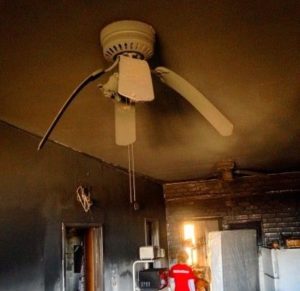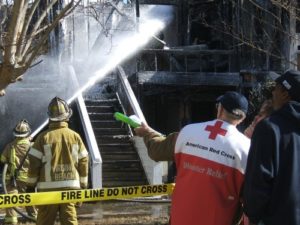Editor’s note: A version of this story originally appeared on the Red Cross Los Angeles Region blog. Story by Joseph Edwards, California Safe Corps and Disaster Action Team Volunteer.

The ceiling fans had melted from the heat. The blades had wilted to mirroring an upside down flower, with the petals pitch black heading toward the floor. It was a very striking image amongst the debris remaining from a fire hours earlier.
When training volunteers to be members of a Disaster Action Team (DAT), the Red Cross covers what to expect in terms of communicating with people in need, assessing the scene and determining the type of assistance we can provide. But, for a trainee like myself, it’s easy to get caught up in the powerful destruction of fire and heat before returning your focus to where it should be: Helping those in need.
On the morning of Friday, February 19, a fire started at the Morningside United Church, located at Manchester and South Crenshaw Blvd, just a few blocks from The Forum in the heart of Inglewood. The modest church also provided assisted housing for individuals, three of whom were now displaced from the fire. One resident lost literally everything she owned.
I was a part of the DAT team deployed to meet with the residents later that afternoon. This was my fourth official DAT call since joining the Red Cross, but my first in over a year. I joined two volunteers, Grant Graves ,the DAT leader, and Alison Berglas, another DAT member, both seasoned pros. As the trainee on the call, my main role was to assist them where I could, watch and learn.
Driving up to the scene is always tense. We have been given facts about the scene verified by the fire department, but we what we really want to know is what is the mood of the individuals affected? Are they calm, are they inconsolable, are they just happy to get help, or are they furious it took us so long to arrive? Some calls last 30 minutes, some can take multiple hours. One doesn’t know until we step out of the car. We arrived at the church a little after 3 p.m. The three of us made a plan and were soon ready to greet the fire victims.

The upstairs of the church functioned like a small dorm. There were small individual rooms, a common-space area with a TV and pool table, and a bathroom down the hall. The smoke damage and debris from the fire made the location uninhabitable. Grant and I surveyed each unit then met with the residents in a downstairs room.
We interviewed them one-on-one. All were very patient, coherent and seemingly unscathed by the fire. For those who have not been on a DAT call, the action on the scene is fairly straight-forward. We interview, we determine the type of help they need and what we can give, we give it to them, we record all this down, and then we leave. The families have contact information if they need further assistance, and we regularly make calls to check in on those we’ve helped to ensure their needs have been met.
But what’s tough is having emotional intelligence. We are dealing with fragile human beings.
An offhand comment or attempt at humor could really unsettle the scene and make it more difficult to give them aid. I was struck by the people on this call and their calm demeanor. They were grateful to get help.
Each received a Client Assistance Card (CAC) and a comfort kit with small items like soap, toothbrush and toothpaste. A CAC works like a debit card and allows the Red Cross to distribute financial assistance for immediate needs like clothing and food.
For two individuals, we looked up nearby motels where they could lodge for several days and directions to the nearest US Bank where they could withdraw funds for immediate necessities.
Leaving the scene is always bittersweet. I left with the hopeful feeling that we have helped three people get back on their feet. But frankly, I don’t know where they will be in a week or in a month.
The most fascinating moment for me happened during the process of allocating the assistance cards to the residents. The Red Cross uses a recording system to enter data after which a case number is assigned to that person or family. The numbers are assigned in chronological order by creation.
In the fifteen minutes between issuing the cards in Inglewood, CA, the case number IDs increased in number by 70. So, in that brief time, all across the country, 70 other cases were being opened to help families affected by home fires. It is inspiring to think about the amount of work that happens each and every day by Red Cross volunteers and staff, and I felt so lucky to be just a small part of it.
Red Cross Home Fire Campaign
In an ongoing effort to reduce death and injury from home fires, the Red Cross Home Fire Campaign is hosting a series of installation and fire safety events across the country. Red Cross volunteers, along with fire departments and other partners, canvass high-risk neighborhoods, installing free smoke alarms, replacing batteries in existing alarms and helping families create escape plans. Since 2014, the Red Cross Home Fire Campaign has saved at least 258 lives and installed more than more than 886,000 smoke alarms in cities and towns across the United States.
Learn how you can help us Sound the Alarm to #EndHomeFires this fall.
If you have been affected by a home fire and need assistance, call us at 1-800-RED-CROSS or visit us at redcross.org to find your local Red Cross chapter.
